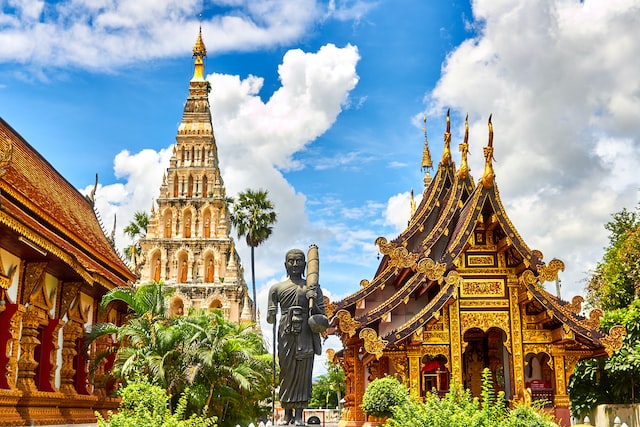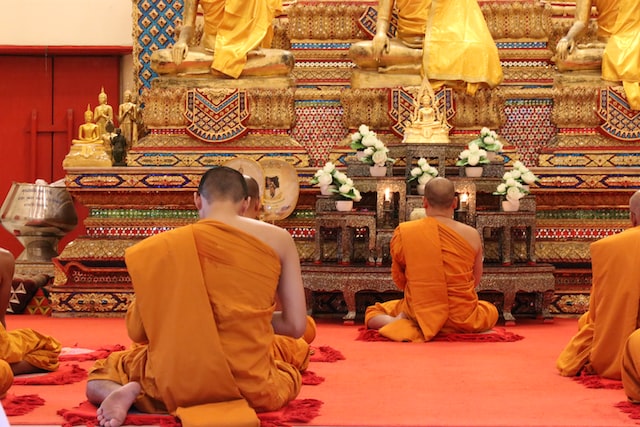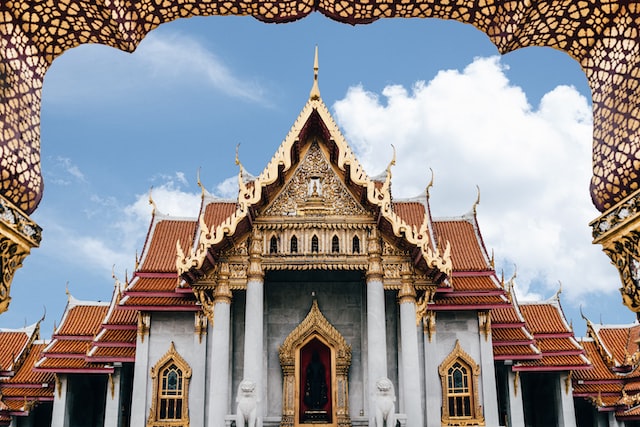Welcome to a lovely, diverse Thailand, where faith and spirituality are valued! Every Thai city has a stunning Buddhist temple, or “wat.” Thailand’s wats are world-renowned and these temples are worship sites and cultural landmarks. They showcase the nation’s rich history and unique architecture. From Bangkok’s lavish temples to Chiang Mai’s hidden gems, Thailand’s temples offer a spiritual and beautiful experience.
In this article, we will discuss the significance of Thailand’s temples as well as their stunning aesthetics. We will also explain why they should be on everyone’s itinerary when visiting this amazing country. So sit back, and let’s get started!
THAILANDS’S RICH CULTURE AND RELIGION

Thailand’s temples might be significant and culturally enriching, but they’re not necessarily required for everyone. It still depends on your Thailand travel goals.
Thailand is largely Buddhist, and temples, or “wats,” are essential in Thai culture and society. These are cultural, historical, and sacred places for worship and meditation. Temples reveal Thai spirituality, art, architecture, and history.
Temples can help you understand Buddhism and Thai culture. If they don’t interest you, Thailand has many additional activities.
Nonetheless, Bangkok’s Grand Palace and Wat Phra Kaew, and Chiang Mai’s temples boost Thailand’s tourism. These monuments offer a glimpse into Thailand’s rich history and architecture, but they can get crowded, especially during peak travel times.
MAJOR ETIQUETTE WHEN VISITING TEMPLES IN THAILAND

🟦 Do not forget to dress correctly!
Dressing appropriately and modestly is recommended when visiting a Thai temple. Keeping your arms, chest, and legs covered is required. Clothes should be baggy, cover the shoulders and knees, and be easy to move around in. Both genders should dress modestly, with males wearing long pants and a shirt that covers their shoulders and women wearing long skirts or dresses or pants with a blouse that does so as well. To avoid being too hot in the tropical sun, wear loose, light-colored clothing.
Bring a light jacket or shawl to cover your arms in case you get cold inside the temple, and make sure you dress appropriately. When planning a trip to a temple, it’s smart to find out in advance if there are any stricter dress requirements.
🟦 Remove your shoes
Always remember to take off your shoes at the door of a Thai temple or shrine, as doing so is one of the most revered rituals. While entering a religious building, such as a temple, it is important to show proper decorum and cleanliness. Before entering the temple, visitors are expected to remove their footwear and place it in the provided receptacle. This space could be a designated shoe rack or cubby outside the temple, or it could be an indoor feature. If you don’t see a designated area for shoe removal, ask a temple staff or take a look at the placards.
Be sure to remove both shoes before entering the temple, and leave your socks and stockings outside. Wandering about in socks or bare feet is fine, and certain religious sites may even supply slippers for guests.
🟦 The Buddha sculptures should not be touched.
You should also not touch any of the Buddha images or statues you see when you’re visiting a Thai temple. To show proper reverence, Buddha statues should be handled with care. Anyone who touches or climbs on a Buddha statue is showing disrespect and possibly even ignorance.
Avoid pointing your feet at the Buddha statues and keep your hands and feet to yourself. If you can’t resist sitting in a certain position, try to cross your legs or fold them under you so that you’re not accidentally aiming your feet at somebody or anything sacred.
🟦 Be quiet
It is crucial to remember that temples are places of devotion and contemplation and to behave appropriately as one would in such a setting. Try not to make too much noise or use your phone. Disturbing the calm in the temple with loud noise is considered rude and disrespectful to the Buddha and any monks who may be present.
Keep your voice down and speak softly if you must. It’s also a good idea to silence or turn off your phone so it doesn’t make any distracting noises. It’s important to be aware of signs posted at temples asking visitors to maintain silence.
🟦 Don’t take photos of people without permission
The people within the temple are there to worship, not to be photographed, so please keep that in mind if you want to take pictures of the temple or its grounds. Without permission, photographing a person can be intrusive and awkward, and the subject may even feel disrespected.
Asking for someone’s permission before taking their picture is always a good idea. It’s polite to seek permission before taking anyone’s picture, even if they appear to be locals or monks who would be eager to pose for photos. Be aware that there may be restricted sections in the temple where photography is not allowed, and act accordingly.
🟦 Don’t show public displays of affection
Although public shows of affection are common in many societies, visitors to Thai temples should keep this in mind. The same goes for kissing, hugging, and holding hands. Modesty and decorum are highly valued in Thai society, particularly when visiting religious sites like temples. The Buddha and any monks who may be present may view public displays of affection as impolite.
When visiting a temple with a significant other, it is appropriate to limit physical contact so as not to disrupt the rituals inside. Avoid dressing provocatively or in revealing apparel, as this can be a lack of respect.
🟦 Recognize the monks as authorities
Monks are held in great regard in Thai society, so visitors to a temple should behave respectfully and deferentially toward them. It would be rude to sit or stand above them. Avoid making eye contact with the monks by pointing your feet away from them and sitting or standing lower than they are.
It is appropriate to address a monk with respect and courtesy due to his status as a religious leader. Avoid personal contact with monks, especially touching or hugging them. Offering something to a monk is best done with the right hand, and direct eye contact should be avoided as it can be misinterpreted as a challenge or contempt.
🟦 Give a gift
Tourist contributions are essential to the preservation and continued operation of temples. When visiting a temple, it is usual to offer a small payment to the temple’s donation box. Visitors are encouraged to make a donation to the temple, regardless of their financial situation, to express their support for the temple and the community it serves.
Both monetary and in-kind contributions are welcome, including but not limited to the provision of food and candles. While giving a donation, please follow the example of other visitors and respect the temple’s traditions. If you aren’t sure how to donate to a temple, it’s a good idea to ask a member of the staff or consult the temple’s signs.
MOST FAMOUS TEMPLES IN THAILAND
Thailand has a rich cultural and Buddhist history. Many famous temples are there including:
1. Wat Phra Kaew
Bangkok’s famous ancient and beautiful temple. This temple, houses the Temple of the Emerald Buddha, one of Thailand’s most revered Buddhist icons. The temple, part of the Grand Palace complex, has exquisite sculptures and glittering gold decorations.
2. Wat Pho
The reclining Buddha statue is famous in Bangkok. This 46-meter-long, gold-leafed Buddha sculpture is one of the world’s most impressive. The temple also has Thailand’s largest collection of Buddha sculptures, with about 1,000.
3. Wat Arun
The Temple of Dawn sits on the Chao Phraya River in Bangkok. Its elegant architecture and Chinese glass and porcelain tiles make it famous. Climbing the temple gives a stunning view of Bangkok and the river below.
4. Wat Saket
Bangkok’s Golden Hill temple sits on a hill. It is popular for its golden chedi, which holds Buddha relics, and its stunning city views from the summit. The temple is full of a lush park that is popular with the community for relaxing and taking in the scenery.
5. Phra That Doi Suthep
Chiang Mai’s hilltop Buddhist temple is one of Northern Thailand’s holiest sites. Its exquisite construction and stunning views of Chiang Mai and the surrounding area make it famous.
6. Chedi Luang
The 14th-century Chiang Mai temple is popular for its massive chedi (stupa). After a 16th-century earthquake, Chiang Mai’s tallest chedi is now a shell. Visitors may see the older chedi that replaced it and the relics of the earlier one.
7. Wat Rong Khun
The White Temple is this temple. Its modern design is famous in Chiang Rai. Chalermchai Kositpipat designed it using white plaster and glass fragments that glitter in the sunlight. Visitors may witness the temple’s magnificent architecture and minute features while it’s being built.
8. Wat Phra Singh
This temple is famous for its architecture and antique Buddha sculptures. In Chiang Mai. The 14th-century temple houses Thailand’s most revered Buddha statue, Phra Buddha Sihing.
9. Mahathat Temple
This temple is famous for its Buddha head entwined in tree roots and its position in Ayutthaya, recognized for its historic ruins. The 14th-century temple became one of Ayutthaya’s most important. Today, visitors may see the temple’s ruins, featuring the Buddha head, one of Ayutthaya’s most famous emblems.
10. Benchamabophit Temple
The Marble Temple is in Bangkok, Thailand. Its marble and architecture are stunning. The marble temple, built in the early 20th century, is unique and luxurious. The temple’s four huge bronze Buddhas are gold-leafed and visitors can see the temple’s intricate carvings and ornaments.
11. Buddhist Wat Suthat
The 25-meter-tall red swing outside this shrine is famous. Bangkok houses the temple. The temple has stunning sculptures, murals, and Buddha figures.
12. Wat Chaiwattanaram
The temple’s architecture and ruins are noteworthy. The 17th-century temple was once Ayutthaya’s most significant highlight. Today, tourists may see the stately chedi, temple ruins, and intricate carvings and embellishments.
13. Lampang Luang Wat
Lampang’s chedi and ruins are also famous in Thailand. The 13th-century temple is one of Northern Thailand’s most visited temples. In addition to the chedi, visitors may see the temple’s stunning murals and carvings.
14. Wat Phukhathong
This Ayutthaya temple is famous for its 50-meter gold chedi. The 15th-century temple, one of Ayutthaya’s most iconic structures, was built. Visitors may see the entire landscape from the top of the chedi.
15. Wat Dok
The temple’s chedi and grounds are remarkable. In Chiang Mai. The 14th-century temple is where Chiang Mai’s rulers are buried and visitors can admire the temple’s gardens and chedi.
COMMON OFFERINGS YOU CAN GIVE INSIDE THE TEMPLE

Thailand’s religious and cultural legacy is shaped by its Buddhist temples. When visiting temples, tourists should observe local customs. Offerings may include:
🟦 Flowers
Temples frequently receive fresh flowers. These are placed in front of the Buddha picture or shrine to show respect and devotion.
🟦 Incense
Thai temples also burn incense. Incense smoke carries prayers and offerings to the gods.
🟦 Candles
Temple offerings include lighting candles. You can place candles before the Buddha image or shrine to show respect and enlightenment.
🟦 Gold-leaf
As a form of worship, gold leaf is often put on Buddha statues. Giving is thought to create positive karma.
🟦 Food
In some temples, monks receive food as merit. It’s best to ask a local guide or temple officials if they accept visitor food offerings.
🟦 Money
Temple donations are another method to give. Many temples feature donation boxes.
FINAL WORDS
Finally, visiting Thai temples can be life-changing. Temples reveal Thailand’s spirituality and culture through its exquisite architecture, beautiful embellishments, and tranquil ambiance.
Thailand’s temples can be gratifying whether you have an interest in Buddhism or just want to relax. There are many temples to see in Thailand, from Wat Rong Khun’s clean walls to Wat Phra Kaew’s energy.
Temple ceremonies and traditions are as fascinating as their architecture. There are various ways to experience Thai culture and spirituality, from viewing monks to participating in ceremonies.
Visitors are encouraged to explore the grounds and ask inquiries while respecting religious rituals. Temple visits can be a highlight of any vacation to Thailand, whether you’ve been there before or not!
You can also click here to know more about the best places to visit in Thailand!
